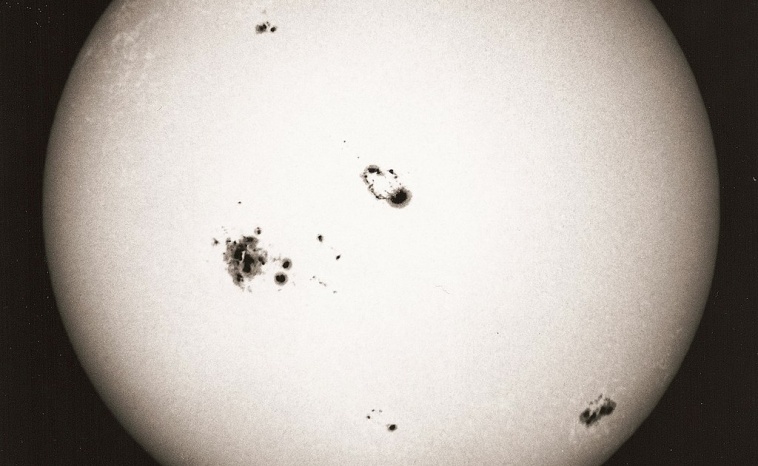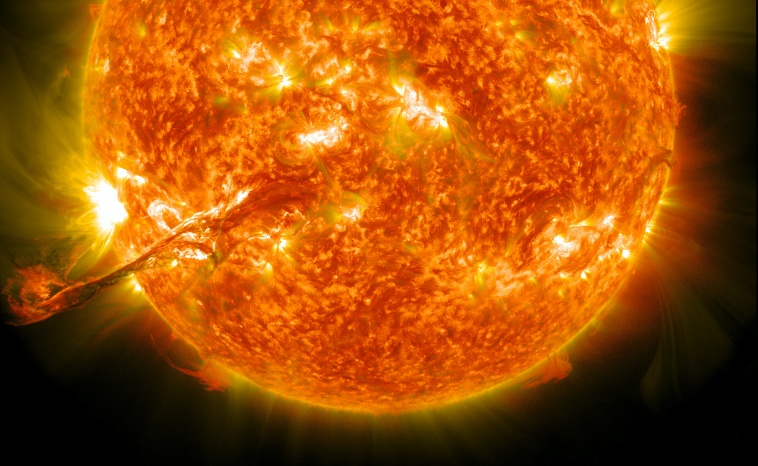What Are Sunspots?

They’ve intrigued us for centuries and still have their mysteries, but what are sunspots? In this article, we’ll take a closer look at the elusive solar phenomena.
The sun holds a prominent place in our corner of the universe. Not only does it sustain life on our planet, but it also serves as the primary energy source for an array of human activities. For centuries, its glorious presence has sparked the imagination of countless individuals. Yet amidst its radiant brilliance lies a captivating enigma: sunspots. These mysterious dark spots, scattered across the sun’s surface, have long intrigued scientists and astronomers, beckoning them to delve deeper into their secrets. But precisely what are sunspots? In this article, we’ll unravel the mysteries of sunspots, exploring their nature, causes, and profound impact.
What Are Sunspots?

Hans Bernhard (Schnobby), CC BY-SA 3.0, via Wikimedia Commons
Hans Bernhard (Schnobby), CC BY-SA 3.0, via Wikimedia CommonsSunspots are fascinating phenomena that appear as dark patches on the sun’s surface. They are the result of intense magnetic activity occurring within our star. Sunspots manifest as regions that are relatively cooler than their surroundings on the sun’s surface, varying in size from just a few hundred kilometres to sizes surpassing that of our planet.
The formation of sunspots is intricately tied to the twisting and tangling of magnetic field lines, which in turn affects the release of energy from the sun’s interior. As a result, sunspots exhibit a distinct dark colour owing to their relatively lower temperature compared to the vast majority of the sun’s radiant surface.
How Do Sunspots Form?
The formation and activity of sunspots occur in cycles known as the solar cycle, which lasts approximately 11 years. These cycles are linked to the sun’s magnetic field and significantly impact various phenomena.
The number of sunspots changes during the solar cycle, with the maximum number occurring at the cycle’s peak. This period, known as solar maximum, features an increase in solar activity, including the formation of large and complex sunspot groups. As the cycle progresses towards solar minimum, the number of sunspots gradually declines, leading to a quieter and less active sun.
While the exact mechanisms behind the solar cycle are still not fully understood, scientists have made significant progress in unravelling its mysteries. Research suggests that the cycle is driven by the interaction between the sun’s magnetic field and its internal dynamics. The sun’s magnetic field plays a crucial role in shaping the formation and evolution of sunspots, as well as influencing other solar phenomena such as solar flares and coronal mass ejections.
Sunspots and Solar Flares

Sunspots and solar flares are intricately connected. A solar flare is an intense burst of radiation that can occur following the sudden release of built-up magnetic energy in the sun’s atmosphere. This typically happens in active regions around sunspots. The radiation from a solar flare is so powerful that it can disrupt radio signals on Earth and, in extreme cases, interfere with power grid operations. Interestingly, during the peak of the solar cycle, when sunspot activity is at its highest, the occurrence of solar flares also significantly increases.
The study of these solar flares, therefore, provides us with crucial information about space weather and its potential impact on Earth’s technological systems. As with many aspects of solar dynamics, our understanding of the relationship between sunspots and solar flares is continuously evolving, thanks to the relentless efforts of solar physicists and the advanced technology at their disposal.
How Do Sunspots Affect Earth?

Sunspots wield a substantial influence on the Earth’s atmosphere, particularly on the ionosphere, an electrically charged layer in the upper atmosphere. The ionosphere plays a vital role in various human activities like communication and navigation. When sunspots emerge, they disturb the Earth’s magnetic field, triggering alterations in the movement of charged particles within the ionosphere. Consequently, communication networks and GPS signals may experience disruptions.
Moreover, sunspots also exert an impact on the Earth’s climate. For instance, during the Maunder Minimum, a period of remarkably low sunspot activity observed from 1645 to 1715, our planet encountered a cooling effect. Certain regions experienced substantially colder temperatures than usual. Although the exact causal relationship between sunspot activity and the Earth’s climate remains partially veiled, it is evident that variations in solar activity can significantly influence our planet’s overall climate dynamics.
History of Sunspot Observation
Sunspot observation has a rich history dating back to ancient times, though the existence of sunspots wasn’t universally acknowledged until telescopic advancements in the 17th century. Chinese astronomers were among the first to document sunspot activity, with records going back to as early as 28 BCE. European observations of sunspots revolved around the work of astronomers such as Thomas Harriot, Johannes and David Fabricius, and Galileo Galilei. Indeed, Galileo’s pioneering use of the telescope in astronomy led to the wide acceptance and understanding of sunspots. His observations revealed that these dark patches, initially thought to be planets or moons in transit, were actually on the sun’s surface.
The regular tracking and recording of sunspots began in the 19th century, with the establishment of the Swiss Federal Observatory in 1847. This marked a significant leap in our understanding of the sun’s activity and its influence on Earth.
Monitoring Sunspots
Sunspot monitoring remains a critical area of study in modern astrophysics, with numerous observatories and space missions dedicated to tracking solar activities. The intricate link between sunspot activity and climate variations on Earth makes this field of study particularly relevant. Significantly, scientists have observed that periods of decreased sunspot activity, often referred to as solar minima, coincide with climatic phenomena such as the ‘Little Ice Age’.
Technological advancements have greatly enhanced the science of sunspot monitoring. Today, we employ sophisticated instruments like the Solar and Heliospheric Observatory (SOHO) and the Solar Dynamics Observatory (SDO), which continually monitor the Sun from space. These observatories capture high-resolution images of the Sun’s surface, allowing for detailed analysis of sunspot activities and their complex magnetic interactions.
This wealth of data enables scientists to study long-term trends in sunspot activity and to enhance our predictive capabilities of solar activity and its climatic impacts. The research continues to evolve, offering valuable insights not only into our own star but also into the broader universe.
How to Identify and Observe Sunspots

Observing sunspots is a fascinating activity that provides an intimate glimpse into our star’s dynamic nature and its influence on our planet. However, identifying and observing sunspots requires specific equipment and strict adherence to safety guidelines. A telescope equipped with a solar filter is indispensable, as direct observation of the Sun can lead to irreversible eye damage. Solar filters reduce the Sun’s brightness to a level that is safe for viewing.
To identify sunspots, one should focus the telescope on the Sun’s disc and adjust the eyepiece for a clear view. Sunspots appear as dark patches against the luminous backdrop of the Sun. Observers should note that sunspots are transitory, and their visibility may differ day-to-day. Similarly, their size and shape can change dramatically over time. To observe these changes, it is helpful to maintain a sunspot diary, recording their position, size, shape, and group configuration.
Final Thoughts
Sunspots remain a fascinating and mysterious phenomenon. Scientists are still studying their impact on the Earth’s atmosphere and climate and are making new discoveries all the time. As we continue to learn more about these dark patches on the sun’s surface, we gain a better understanding of the complex interactions that drive our universe and the impact they have on our planet.
While we still have plenty to learn about sunspots, there are plenty of interesting facts you can discover about the stars and constellations right now using the OSR Star Finder App. Simply download the app to your iOS or Android smart device and explore some of the night sky’s most fascinating objects.

